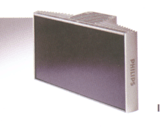Equipment
We utilize the Philips Digital Congress Network (DCN) interpretation system line. The DCN interpretation system uses an advanced DCN Interpreters Desk with LCD display clearly displaying the outgoing and monitor channel selections in a number of languages. The design of the mic switch with it's solid mechanical feel coupled with the LED mic ring light and large red LED "mic active" bar give positive response of microphone activation.
The multichannel, Modular Transmitter allows up to 16 channels of transmission in 4 channel modules with either DCN digital or analog input. The availability of two local IR led emitters allow simple monitoring of transmission from the transmitter face.
The infrared signal is fed into the conference room through a variety of Infrared Emitters all featuring quiet operation due to an integrated heat dissipation fins and a modern appearance.
Of course, no transmission system is complete without receivers, in the DCN system there are a number of receiver options. DCN discussion and standard microphone system can be ordered with integrated channel selectors and standalone wired channel selectors are available for flush mount or desktop use. There are also Infrared Receivers available in 2, 7 and 16 channel models with units available with disposable or rechargeable batteries.
One of the most important and quite often overlooked aspects of a simultaneous interpretation systems is the interpretation booths. The booth needs to be attractive and yet functional in that it needs to isolate the interpreters from the conference so that they do not interfere with the proceedings but, yet allow them to have full view of the proceedings and visuals in a comfortable workplace where an interpreter may spend many hours every day.
Church Interpretation Systems
If you require a small interpretation system for use by a few members in your congregation who need simultaneous language interpretation we can provide a Listen Wireless FM system with portable receivers and a base transmitter in the 216Mhz frequency band which is licensed for use for simultaneous interpretation.
The use of a multichannel receiver allows more than one language to be interpreted at one time allowing congregations to bring together different language groups without have separate services. the use of simultaneous interpretation allows the message to be heard by all congregants at the same time without the delay associated with consecutive interpretation. The use of a professional interpretation system allows the interpreter to be in a separate room away from the congregation allowing them to concentrate and not have to worry about disturbing other congregation members. The small wireless receiver with separate volume control allows those needing interpretation to blend in with the congregation as a whole and has the added benefit, with an additional transmitter, of providing auditory assistance for the hearing impaired.
Benefits:
- Allows all language groups to be together
- Cost benefit of having only one service for many languages
- Provides auditory assistance for the hearing impaired
- Small, unobtrusive wireless receiver
- Simple setup of transmitter unit
- 216 Mhz frequency band licensed by the FCC for interpretation
- Simple operation, turn on and forget
Infrared Technology

Infrared emitter
How it Works
An infrared transmission system is comprised of three components, the transmitter, the infrared emitter (also called radiator) and the receiver. The transmitter modulates the audio signal onto a carrier frequency using F.M. or digital techniques. The emitter takes the modulated signal and converts it into infrared light. The receiver decodes the infrared signal and coverts it back to an audio signal which is sent to the headphone.
In a multichannel system the transmitter generates a carrier wave for each channel. All the modulated carrier waves are mixed, and are fed via a coaxial cable from the transmitter to the infrared emitters. The output of the emitters is modulated infrared light, which is invisible to the human eye. Each user is given their own pocket receiver. This receiver has a lens which collects the infrared light, and directs it to an IR sensitive receptor. he receiver has electronics to decode the received signals, and to output one of the signals (selected by a channel selector) to the headphone connector.
In a conference or theater setting the transmitter can be placed anywhere within about 1,000 feet of the radiators. The radiators need to be placed around the area to be covered by a technician with knowledge about the dispersion pattern of the emitter and the power output. These radiators are connected in a daisy chain configuration around the hall to give adequate signal strength to the entire area to be covered. Additional emitters may be placed back stage or in over flow rooms as the signal will not travel through walls.
Advantages
The of an infrared transmission system are fully realized when different programs are required in adjacent rooms, such as a multiplex cinema or conference center. Each room can be equipped with a separate infrared system without interference between rooms. In the case of a multichannel transmission system, a delegate can go from room to room and keep the same channel for their particular language. Additionally, since the signal is transmitted via infrared light there is little change of radio frequency interference.


